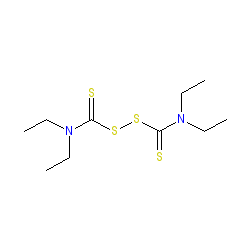GtoPdb is requesting financial support from commercial users. Please see our sustainability page for more information.
|
Synonyms: Antabuse® | NSC-25953
disulfiram is an approved drug (FDA (1951))
Compound class:
Synthetic organic
Comment: Disulfiram inhibits acetaldehyde dehydrogenase to expedite acetaldehyde accumulation and rapid onset (within 5-10 minutes of alcohol intake) of the unpleasant effects typical of a hangover.
Ligand Activity Visualisation ChartsThese are box plot that provide a unique visualisation, summarising all the activity data for a ligand taken from ChEMBL and GtoPdb across multiple targets and species. Click on a plot to see the median, interquartile range, low and high data points. A value of zero indicates that no data are available. A separate chart is created for each target, and where possible the algorithm tries to merge ChEMBL and GtoPdb targets by matching them on name and UniProt accession, for each available species. However, please note that inconsistency in naming of targets may lead to data for the same target being reported across multiple charts. ✖ |
|
|||||||||||||||||||||||||||||||||||
| No information available. |
Summary of Clinical Use  |
| Used as a form of aversion therapy to treat chronic alcoholism, in co-operative patients, and combined with appropriate supportive care. |
Mechanism Of Action and Pharmacodynamic Effects  |
| Disulfiram inhibits the mitochondrial form of aldehyde dehydrogenase (ALDH2). Members of this small enzyme subfamily are normally involved in alcohol metabolism, principally the oxidation of acetaldehyde to acetate. When ALDH2 is inhibited acetaldehyde levels rise and this is responsible for inducing flushing, nausea, vomiting, tachycardia, and hypotension. These unpleasant side effects are intended to act as a deterent to alcohol consumption. |
External links  |
|
For extended ADME data see the following: Electronic Medicines Compendium (eMC) Drugs.com |







